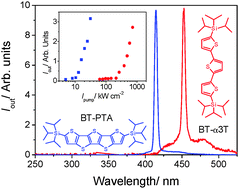Effect of ring fusion on the amplified spontaneous emission properties of oligothiophenes†
Abstract
We report the observation of amplified spontaneous emission (

Maintenance work is planned for Wednesday 1st May 2024 from 9:00am to 11:00am (BST).
During this time, the performance of our website may be affected - searches may run slowly and some pages may be temporarily unavailable. If this happens, please try refreshing your web browser or try waiting two to three minutes before trying again.
We apologise for any inconvenience this might cause and thank you for your patience.
* Corresponding authors
a
Instituto Universitario de Materiales de Alicante (IUMA) and Unidad Asociada CSIC-UA, Universidad de Alicante, Alicante 03080, Spain
E-mail:
maria.diaz@ua.es
b Dpto. Física Aplicada, Universidad de Alicante, Alicante 03080, Spain
c Dpto. Física, Ingenería de sistemas y teoría de la señal, Universidad de Alicante, Alicante 03080, Spain
d Dpto. de Óptica, Universidad de Alicante, Alicante 03080, Spain
e Macromolecular Science and Engineering Program, University of Michigan, 930 North University, Ann Arbor, Michigan 48109-1055, USA
f Departament of Physical Chemistry, University of Málaga, 29071 Málaga, Spain
We report the observation of amplified spontaneous emission (

 Please wait while we load your content...
Something went wrong. Try again?
Please wait while we load your content...
Something went wrong. Try again?
V. Navarro-Fuster, E. M. Calzado, M. G. Ramirez, P. G. Boj, J. T. Henssler, A. J. Matzger, V. Hernández, J. T. López Navarrete and M. A. Díaz-García, J. Mater. Chem., 2009, 19, 6556 DOI: 10.1039/B907106G
To request permission to reproduce material from this article, please go to the Copyright Clearance Center request page.
If you are an author contributing to an RSC publication, you do not need to request permission provided correct acknowledgement is given.
If you are the author of this article, you do not need to request permission to reproduce figures and diagrams provided correct acknowledgement is given. If you want to reproduce the whole article in a third-party publication (excluding your thesis/dissertation for which permission is not required) please go to the Copyright Clearance Center request page.
Read more about how to correctly acknowledge RSC content.
 Fetching data from CrossRef.
Fetching data from CrossRef.
This may take some time to load.
Loading related content
